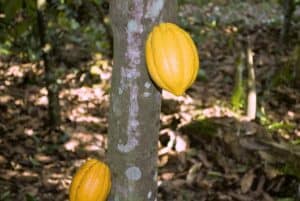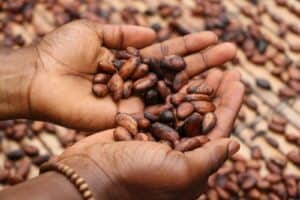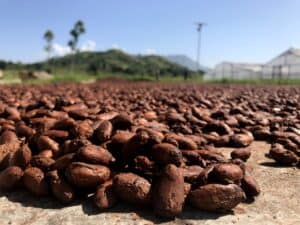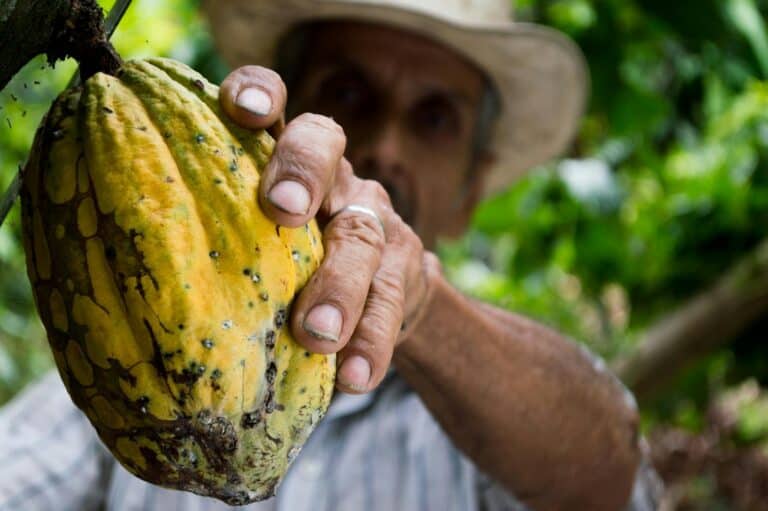Cocoa farming stands at the heart of rural economies in many tropical countries, but the sustainability of cocoa farmers’ livelihoods is under threat. This critical issue doesn’t just affect the farmers but ripples through to labor sellers, petty traders, and the staff of cocoa marketing companies who depend on the industry for their secondary livelihoods. With challenges like land degradation, corruption, and the pressures from emerging industries, cocoa farmers are finding it increasingly difficult to sustain their way of life.
Understanding the sustainability of cocoa farmers’ livelihood is essential, not just for the farmers themselves but for the global economy and chocolate lovers everywhere. Factors such as initial capital, environmental impact, and market forces play significant roles in shaping the future of cocoa farming. By diving into these issues, we can uncover the pressures and driving forces behind the sustainability of cocoa farming and explore how international stakeholders can contribute to a fairer, more sustainable future for these vital agricultural workers.
Understanding the Cocoa Farmers’ Livelihood

Cocoa farming represents the backbone of livelihoods for smallholder farmers, particularly in West Africa, home to a significant portion of the world’s cocoa production. For these farmers, cocoa serves not only as a primary source of income but also as a critical component of household food security and overall economic stability. The income derived from cocoa farming is influenced by several factors, including farm size, crop yields, and market prices. Investment in good agricultural practices and crop management can markedly improve yields, contributing to increased household income. However, achieving sustainable cocoa farming and ensuring a living income for farmers poses several challenges.
Access to fair wages and market support plays a crucial role in the livelihoods of cocoa farmers. Practices such as the living income differential and fair trade certifications aim to ensure farmers receive a fair share of the profits from cocoa production, supporting their ability to cover basic needs such as healthcare, education, and housing. Nonetheless, many cocoa-growing households remain below the living income benchmark, highlighting the need for ongoing support and intervention from both the cocoa sector and international stakeholders.
The cocoa sector’s commitment to improving farmers’ livelihoods has seen initiatives like the Cargill Cocoa Promise and participation in UTZ Certified programs, focusing on empowering farmers with better agricultural practices, financial management skills, and access to global markets. These efforts aim to enhance farm productivity, improve incomes, and ensure the sustainability of cocoa farming communities. By understanding and addressing the challenges faced by cocoa farmers, stakeholders can contribute significantly to their welfare, helping maintain the global supply of cocoa while ensuring the farmers’ livelihoods are sustainable and resilient against economic pressures and environmental changes.
Economic Impact on Cocoa Farmers
The economic impact on cocoa farmers, particularly smallholder farmers in regions like West Africa, where the majority of the world’s cocoa originates, cannot be understated. Cocoa farming serves as the backbone of many rural economies, yet many farmers struggle to achieve a living income. The net annual income required for a decent living standard—a concept known as the living income benchmark—often exceeds what most cocoa farmers earn from their crop.
Factors like fluctuating cocoa prices, high input costs for fertilizers and disease management, and limited access to markets contribute to this disparity. Initiatives aimed at supporting cacao farmers, such as fair wages in cocoa production and the cocoa sector’s living income differential, strive to bridge this gap, yet the challenge persists.
Investing in good agricultural practices and providing access to financial services enable cocoa farmers to improve their incomes. Research shows that when farmers adopt best management practices, their yields and, consequently, incomes can increase. However, many farmers in the developing world lack the resources to invest in their farms. Cash transfer programs and participating cooperatives offer a lifeline, allowing farmers to purchase necessary inputs and adopt practices that lead to higher productivity. Moreover, companies within the cocoa sector are increasingly recognizing their role in empowering chocolate growers through initiatives like the Cargill Cocoa Promise and UTZ Certified programs, aiming to ensure farmers receive fair compensation for their efforts.
Despite these efforts, a significant number of cocoa farming households in regions such as Côte d’Ivoire and other parts of West Africa remain below the living income threshold, facing challenges related to food security, healthcare, and education. The collective action of companies, governments, and non-profit organizations, aimed at enhancing the livelihoods of cocoa farmers, is critical. By emphasizing the importance of a living income, improving access to agricultural education, and supporting sustainable practices, stakeholders can contribute significantly to improving the economic well-being of cocoa farmers, ensuring they not only survive but thrive in their essential role within the global agriculture landscape.
Strategies to Improve Livelihoods
Investing in Good Agricultural Practices (GAP) stands paramount for coco farmers aiming to improve their earnings. By focusing on crop management, disease prevention, and efficient use of fertilizers, you can significantly enhance crop yields and, consequently, income from cocoa production. For example, TechnoServe’s work in West Africa, training nearly 5,000 Ivorian farmers on input application and credit management, demonstrates how knowledge transfer and skill development contribute markedly to income improvements. Additionally, adopting GAP such as intercropping and shade management can lead to healthier cocoa plants and diversified farm income sources, offering a buffer against the volatility of cocoa prices.
Access to credit and financial services enables smallholder farmers to invest in necessary agricultural inputs like quality seeds and fertilizers, leading to increased yields and incomes. The Cocoa Livelihoods Program (CLP), by facilitating nearly 10,000 farmers to receive credit, showcases the impact of financial inclusion in the cocoa sector. By engaging with microfinance institutions and establishing risk-sharing agreements between cocoa exporters, input suppliers, and lenders, farmers become equipped to make the necessary investments in their farms, ensuring improved livelihoods through enhanced productivity.
Empowerment through Cooperative Participation offers another effective route to bolstering cocoa farmers’ livelihoods. Participating in cooperatives allows farmers to achieve fair wages for their cocoa production by leveraging collective bargaining power. This model also opens avenues for receiving training on best management practices and gaining access to larger markets or premium price contracts. Enhancing participation rates in cooperatives can provide cocoa farmers with the support structure needed to navigate the complexities of the cocoa sector, from ensuring food security to managing input costs and accessing new technologies for sustainable farming practices.
Potential Solutions to Increase Farmer Income

Investing in Good Agricultural Practices (GAP) presents a pivotal step towards enhancing the livelihoods of cocoa farmers. By adhering to GAP, you not only improve crop yields but also ensure the quality of the cocoa beans produced. This directly correlates with receiving better market prices, significantly contributing to the increase in net annual income required for a sustainable livelihood. Cocoa farmers, particularly smallholder farmers, can benefit from training programs focused on crop management, disease prevention, and the efficient use of fertilizers. These educational interventions equip farmers with the knowledge to increase their cocoa production effectively while maintaining the health of their farms.
Another key strategy involves expanding access to financial services and credit schemes dedicated to supporting cacao farmers. Such access enables farmers to invest in necessary inputs like high-quality seeds and fertilizers, which are essential for boosting crop yields. For instance, TechnoServe’s integration with microfinance partners demonstrates the positive impact of providing targeted financial support. By ensuring that a larger percentage of farmers receive the funds and resources needed, you elevate their potential to achieve greater food security and improve incomes. Additionally, the collaboration with organizations like Kiva for refinancing reflects a significant commitment towards empowering chocolate growers and enhancing cocoa farmers’ livelihoods.
Embracing the living income differential and advocating for fair wages in cocoa production also play critical roles in securing the economic well-being of cocoa growing households. By setting a benchmark for net annual income, stakeholders across the cocoa sector, including companies and cooperatives, can work towards ensuring that farmers earn enough to meet their basic needs, including food, housing, healthcare, and education. Furthermore, initiatives like the Cargill Cocoa Promise aim to support cocoa producers by offering them possibilities to engage in more profitable and sustainable farming practices. Together, these solutions form a comprehensive approach to uplift the economic status of cocoa farmers, ensuring that they and their families can enjoy improved livelihoods and step out of poverty.
Global Initiatives and Their Impact

Global initiatives play a pivotal role in transforming the cocoa farming landscape, fostering a more stable and sustainable livelihood for cocoa farmers. Notably, efforts like the Cocoa Livelihoods Program and partnerships among major companies, NGOs, and local governments contribute significantly to this cause. For instance, the Cargill Cocoa Promise and programs led by Mars Incorporated focus on empowering chocolate growers by investing in good agricultural practices (GAP), improving access to markets, and ensuring fair wages in cocoa production. These programs aim to elevate cocoa farmers’ net annual income, pushing it closer to or beyond the living income benchmark, a critical factor in combating poverty and enhancing food security among cocoa-growing households.
Investments in research to increase crop yields and resist disease, alongside training for smallholder farmers on management practices, form another significant approach to support cocoa farmers’ livelihoods. The introduction of disease-resistant cocoa varieties and education on the use of fertilizers and pesticides are examples of how such initiatives can lead to better crop health and higher yields. Moreover, by facilitating access to financial services, these initiatives ensure farmers can afford essential inputs like fertilizers and invest in improvements to their farms and housing, directly impacting their and their families’ well-being.
The concept of the living income differential, introduced in countries like Côte d’Ivoire and Ghana, exemplifies a strategic move to improve incomes by guaranteeing cocoa farmers a minimum price above the global market rate for their cocoa beans. This, combined with efforts to link farmers with participating cooperatives that adhere to best management practices, aims not only to uplift farmers from poverty but also to sustain the cocoa sector’s future. Through concerted efforts encompassing fair trade premiums, cash transfers for healthcare and education, and investments in community development, global initiatives are making strides toward securing a brighter future for cocoa farmers and their families, ensuring they achieve a living income and contribute positively to the agriculture sector.
Wrapping up: Cocoa Farmers Livelihood
Understanding the plight of cocoa farmers and the initiatives aimed at improving their livelihoods is crucial. Through efforts like the Cocoa Livelihoods Program and partnerships with major companies and NGOs, there’s a beacon of hope for these farmers. By focusing on fair wages, market access, and sustainable farming practices, these programs are making strides towards ensuring cocoa farmers enjoy a living income.
The introduction of disease-resistant cocoa varieties and the emphasis on Good Agricultural Practices are pivotal in enhancing crop yields and quality. Moreover, the living income differential set by countries such as Côte d’Ivoire and Ghana showcases a significant step towards fair compensation. It’s evident that with continued support and investment, the future for cocoa farmers looks promising. Their invaluable contribution to the global cocoa industry cannot be overstated, and it’s imperative that we keep pushing for policies and practices that uplift and sustain their livelihoods.
Other suggested articles:
